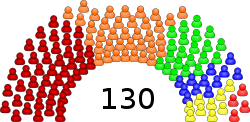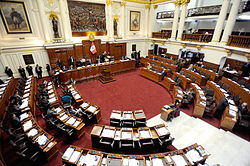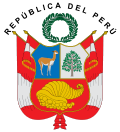- Congress of the Republic of Peru
-
Congress of the Republic of Peru
Congreso de la República
Type Type Unicameral Leadership President of Congress Daniel Abugattás,
Peru Wins
since July 27, 2011Structure Members 130
(since 2011)
Political groups Peru Wins
Force 2011
Possible Peru
Alliance for the Great Change
National Solidarity
Peruvian Aprista PartyElections Last election April 10, 2011 Meeting place 
Palacio Legislativo (Plaza Bolívar, Lima 01) Website Congress of the Republic of Peru Peru 
This article is part of the series:
Politics and government of
PeruExecutive PowerJudicial PowerLegislative PowerAuton. institutionsElectionsPolitical partiesRegional gov'tsLocal gov'ts
The Congress of the Republic of Peru (Spanish: Congreso de la República) or the National Congress of Peru (Spanish: Congreso Nacional del Perú) is the unicameral body that assumes legislative power in Peru.
Congress consists of 130 members of congress (congresistas), who are elected for five year periods in office on a proportional representation basis. To be eligible, candidates must be Peruvian citizens, have passed their 25th birthday, and not have had their right to vote suspended. The last congressional election was held on April 10, 2011, concurrently with the presidential election.
Since July 27, 2011, the President of Congress is Daniel Abugattás, of the Peru Wins political party
Currently the Peruvian congress congregates at the Palacio Legislativo, which is located in the Historical Center of Lima, across the road from Plaza Simón Bolívar and a few blocks away from Casa de Pizarro.
Contents
Historical
Under its 1980 constitution (adopted in 1979 and abrogated in 1993), Peru had a bicameral Congress, made up of a Senate and a Chamber of Deputies. The Senate had 60 members; the Chamber, 180. Members of both chambers were elected for five-year terms, running concurrently with that of the president. Party-list proportional representation was used for both chambers: on a regional basis for the Senate, and using the D'Hondt method for the lower house. Members of both houses had to be Peruvian citizens, with a minimum age of 25 for deputies and 35 for senators.
Following the auto-coup of 1992, in which Congress was dissolved, the Democratic Constitutional Congress established a single chamber of 120 members.
Composition of the Peruvian Congress
Peruvian Congress of 1995-2000
On July 27, 1995 a new unicameral Congress was created with the following distribution by political party:
- Change 90-New Majority (Alberto Fujimori): 74 seats.
- Independents: 16 seats.
- Union for Peru (Javier Pérez de Cuéllar): 8 seats.
- Christian People's Party (Luis Bedoya Reyes): 7 seats.
- Peruvian Aprista Party (Jorge Del Castillo): 7 seats.
- Popular Action (Fernando Belaúnde): 6 seats.
- Democracy in Action: 6 seats.
Peruvian Congress of 2000-2001
On July 27, 2000 the Congress of the Republic was established. This Congressional period was marked with various episodes of members of Congress switching their party affiliation. The following distribution marks seats by party at the end of the 2000-2001 term:
- Peru Possible (Alejandro Toledo): 21 seats.
- Let's Go Neighbor (Alberto Fujimori): 18 seats.
- Peru 2000 (Alberto Fujimori): 18 seats.
- Sin agrupación: 16 seats.
- No Agrupados: 11 congresistas.
- Parliamentary Independent Group: 10 congresistas.
- Independent Moralizing Front (Fernando Olivera): 7 seats.
- With Force Peru (Pedro Koechlin): 7 seats.
- Democratic Parliamentary Group: 6 seats.
- Popular Action-Union for Peru (Fernando Belaúnde and José Vega): 6 seats.
Peruvian Congress of 2001-2006
On July 21, 2001 a new Congress of the Peruvian Republic was established the following is a distribution of Congress members by political party affiliation:
- Peru Possible (Alejandro Toledo): 35 seats
- Peruvian Aprista Party (Alan García): 28 seats
- National Unity (Lourdes Flores): 12 seats
- Independent Moralizing Front (Fernando Olivera): 7 seats
- Peru Now (Luis Guerrero): 6 seats
- Other parties: 27 seats
Peruvian Congress of 2006-2011
A new Peruvian Congress of the Republic was established in July 2006 with the following distribution:
- Union for Peru (Ollanta Humala): 45 seats.
- Peruvian Aprista Party (Alan García): 36 seats.
- National Unity (Lourdes Flores): 17 seats.
- Alliance for the Future (Martha Chávez): 13 seats.
- Center Front (Valentín Paniagua): 5 seats.
- Possible Peru (Alejandro Toledo): 2 seats.
- National Restoration (Humberto Lay): 2 seats.
Peruvian Congress of 2011-2016
- Peru Wins (Ollanta Humala): 47 seats.
- Force 2011 (Keiko Fujimori): 37 seats.
- Possible Peru (Alejandro Toledo): 21 seats.
- Alliance for the Great Change (Pedro Pablo Kuczynski): 12 seats.
- Alliance National Solidarity (Luis Castañeda): 9 seats.
- American Popular Revolutionary Alliance: 4 seats.
Presidents of Congress
Presidents of the Congress of the Republic Beginning of Term End of Term Name of President Political Party Party Leader July 27, 1995 July 26, 1996 Martha Chávez Change 90-New Majority Alberto Fujimori July 27, 1996 July 26, 1997 Víctor Joy Way Change 90-New Majority Alberto Fujimori July 27, 1997 July 26, 1998 Carlos Torres y Torres Lara Change 90-New Majority Alberto Fujimori July 27, 1998 July 26, 1999 Víctor Joy Way Change 90-New Majority Alberto Fujimori July 27, 1999 July 26, 2000 Martha Hildebrandt Change 90-New Majority Alberto Fujimori July 27, 2000 November 13, 2000 Martha Hildebrandt Peru 2000 Alberto Fujimori November 13, 2000 November 16, 2000 Luz Salgado¹ Peru 2000 Alberto Fujimori November 16, 2000 November 22, 2000 Valentín Paniagua Corazao² Popular Action Fernando Belaúnde December 15, 2000 July 26, 2001 Carlos Ferrero Costa³ Peru Possible Alejandro Toledo July 27, 2001 July 26, 2002 Carlos Ferrero Costa Peru Possible Alejandro Toledo July 27, 2002 July 26, 2003 Carlos Ferrero Costa Peru Possible Alejandro Toledo July 27, 2003 July 26, 2004 Henry Pease Peru Possible Alejandro Toledo July 27, 2004 July 26, 2005 Antero Flores Aráoz National Unity Lourdes Flores July 27, 2005 July 26, 2006 Marcial Ayaipoma Peru Possible Alejandro Toledo July 27, 2006 July 26, 2007 Mercedes Cabanillas Peruvian Aprista Party Alan García July 27, 2007 July 26, 2008 Luis Gonzales Peruvian Aprista Party Alan García July 27, 2008 July 11, 2009 Javier Velásquez Peruvian Aprista Party Alan García July 11, 2009 July 26, 2009 Alejandro Aguinaga Alliance for the Future Alberto Fujimori July 27, 2009 July 26, 2010 Luis Alva Castro Peruvian Aprista Party Alan García July 27, 2010 July 26, 2011 Cesar Zumaeta Peruvian Aprista Party Alan García July 27, 2011 Daniel Abugattás Peru Wins Ollanta Humala - ¹ Luz Salgado temporarily assumed the position of President of Congress after a motion to censure President Hildebrandt.
- ² Valentìn Paniagua, was elected President of Congress and as such simultaneously served as President of the Transitional Government.
- ³ Carlos Ferrero Costa, was assigned to President of Congress by an agreement between different political parties.
External links
Categories:- Government of Peru
- National legislatures
- Unicameral legislatures
Wikimedia Foundation. 2010.


